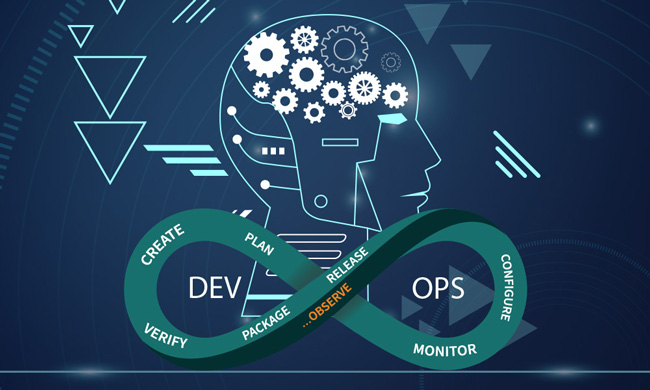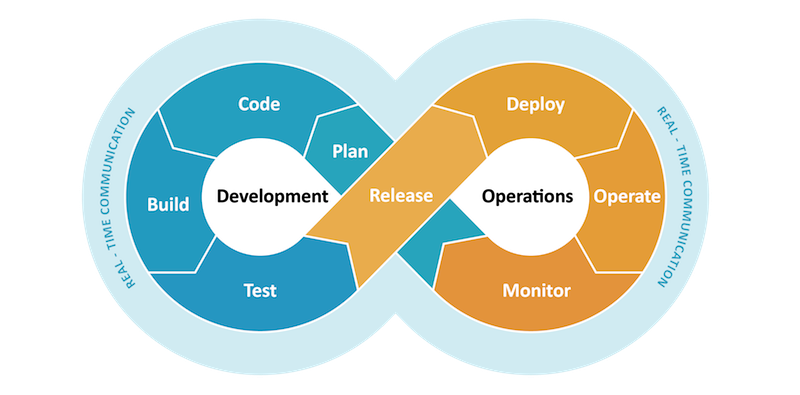Top 10 DevOps Trends to Watch 2024


When customer preferences are constantly evolving and changing constantly, only a few tech companies can guarantee satisfaction with their customers and exceed expectations for business success each time! Innovative business strategies aided by an exemplary implementation of DevOps can help these businesses get consistent and measurable outcomes as they design, launch, improve, and market new products.
DevOps solutions help businesses automate the development and testing process by automating and standardizing code migration and deployment across a variety of environments. They allow developers to establish continuous feedback loops that allow them to decrease response time and deliver software continually based on client feedback and their usage habits. Also, they enable an easy deployment process that allows each code check-in to be integrated into production.
This article will assist you in discovering the most current DevOps trends that will increase technological innovation and digital transformation by 2024.
The 10 Most Important DevOps Predictions For 2024
1. Container Adoption Leading DevOps Strategy
One of the main factors that contribute to the growth of DevOps is the increasing usage of container technology. Containers are self-contained, lightweight environments that make managing and hosting web applications simpler. They are designed to be quick, efficient, reliable, and stable.
In 2023, Gartner estimates that 70% of enterprises have two or more containerized applications. The utilization of Kubernetes and container-native services for storage, networking, and security will continue to rise. Speed and agility will be essential as applications get more complicated. Containers are the most efficient method to create applications that can be scaled and quickly updated to include new features and resolve customer problems to gain a competitive edge.
As more apps are created, and modifications are made more quickly, DevOps will have to face delays in data. In the Cloud, customers are searching for platforms to help solve their problems.
2. Serverless computing
The idea of serverless computing is emerging as an exciting and new method of deploying software and other applications. Serverless computing helps streamline DevOps operations while improving the scalability of architecture and lowering costs. While automating software development, DevOps encompasses the entire software development process, from conception up to testing, deployment, and maintenance in one location. Serverless computing can help developers reduce their burden by handling server maintenance, including updates to the system and cloud monitoring.
Bringing Dev and Ops teams together and removing their differences offers enormous benefits for DevOps. Developers don’t have to access infrastructure execution because they’re connected with cloud servers. Serverless computing produces codes to run DevOps pipelines without the need for hosting to build, test, and deploy. This simplifies deployments and decreases expenses by centralizing infrastructure and business strategy.
3. Microservices Architecture
Microservices architecture is growing in popularity in the IT industry as a viable alternative to the traditional architectural model. Microservices architecture and practices of DevOps let teams decentralized to develop faster, keep control over their tech standardization and stack, monitor the performance metrics, oversee the release and development cycles, and ultimately cut down the time to market by speeding the process of development and release.
Microservices are a great way to help cloud computing break powerful monolithic software into manageable, smaller units. This technique allows teams to get shorter release times for software. You can develop new products or modernize existing software faster using the latest microservices technology if you have a well-designed strategy with well-organized teams and solid DevOps procedures.
4. The Rising of DevSecOps
Security is an issue of great importance in the new digital world. Companies are continuously being forced to be more agile, and security teams have to work to stay on top of testing demands. That has resulted in the rise of DevSecOps. DevSecOps incorporates the best practices in the software development, delivery, and operations with a focus on observability and security; thus, the risks and vulnerabilities of the software are reduced. Security is not a last-minute thought, and it is a factor that is ingrained from the beginning.
DevSecOps assists in closing the gap in security knowledge in IT and business. It assists in the early detection of cyber threats and the cost reduction related to their resolution. The DevSecOps method ensures the safety and security of systems as per the current DevOps trends and the potential of the future.
5. Low-code applications
Implementing a low-code method of DevOps can be a game-changer for any team. The speed and agility that low-code enables will provide any company with an advantage over competitors in today’s fast-paced, competitive software market. Low-code platforms let you create apps with no coding knowledge. It allows people who are not technical to help develop software through an intuitive interface that oversees the entire process of developing apps. It lets users create their processes and logic through the drag and drop of elements. This style of DevOps can speed up the whole process of development and deployment by enabling user-friendly and straightforward applications.
Tools for programming that automate the deployment of applications can easily interface using a low-code platform. They also assist with the essential DevOps practices like building validation, version control, and quality assurance. The availability of a single platform that can provide all of these with “no” and “low” codes can assist DevOps teams to work more efficiently while reducing the overall complexity. Low code means less emphasis on coding, while DevOps is a way to collaborate effectively; the combination of both results in quicker implementation and development.
6. Increased adoption of GitOps
GitOps, a recent update in the DevOps workflow, is a method of managing and automating infrastructure. GitOps can be described as a Kubernetes-based system that lets developers and IT teams working on operations use Git for managing clusters and developing applications. Through the implementation of the Git workflow in the operations and development groups, programmers can utilize Git pull requests to control software and infrastructure deployment.
To manage cloud-native and clustered applications using CI/CD, GitOps uses traditional tools for development. It streamlines cloud-native app deployment maintenance, monitoring, and deployment with Git to serve as one point of truth.
GitOps is among the methods to deploy as well as manage Kubernetes clusters. Through incremental updates, continuous delivery allows teams working on development to create tests, deploy, and build software much faster. Kubernetes’ continuous integration pipeline and runtime pipeline must be capable of writing and reading documents to Git and updating repository repositories for containers or loading the containers. Control of the version for configuration changes and living monitoring, alerting, and notifications are all feasible through GitOps and enable businesses to manage their infrastructure better.
7. Increased need for infrastructure as code
Infrastructure as Code (IaC) is a step over DevOps automation. Infrastructure as code streamlines provisioning and management of resources using code rather than using tools for configuration. As the complexity of environments increases, infrastructure management becomes increasingly complicated and prone to human errors. One of the significant advantages of the IaC method is that it permits the standardization of infrastructure and rapid implementation.
This allows organizations to create solid, consistent systems easily replicated and used across testing, development, or production systems. DevOps teams can manage and provide all aspects of the environment, such as operating systems, VMs containers, application configuration storage, networking, and connections between components using an infrastructure-as-code.
Infrastructure as Code (IaC) significant benefits include:
- Simple cloud-native deployments.
- Progressively transitional architecture.
- Traceability.
- The ability to deliver similar configurations.
- Increased efficiency across the entire process of software development.
8. Implementing DevOps practices using AI and Machine Learning
Optimizing DevOps processes is vital in keeping up with evolving work and environment. AI and Machine Learning can help DevOps teams increase their efficiency by enhancing feedback loops and managing alerts. Developers gain by AI or ML by looking at previous app performance to operational metrics as well as identifying and analyzing patterns as well as sentiment analysis, building successful tests, and even completing the test.
More advanced analytical techniques, like predictive analytics, will be more critical as the market changes. Forecasting is the ability of an organization to forecast future trends in DevOps behavior, actions, and behavior. In DevOps, AI and deep learning, data mining, statistics, and modeling could soon be the standard. This means that the DevOps process that includes AI and ML could soon be part of your process.
9. Automation
Automation is now at the center of DevOps strategies that allow businesses to increase their efficiency, responsiveness, and transparency to their clients. Every aspect involved in DevOps and QA has to be flexible to meet the ever-growing requirements of the future. With regards to continual change, each phase has specific changes. It’s crucial for those working in DevOps and QA to keep the highest degree of technical proficiency and multitasking abilities. One way to prevent this is to implement and speed up the automation process.
Developers try to automatize the most laborious tasks to focus their efforts on productive activities, i.e., be focused on the development of new ideas. It is possible to prioritize tasks and automate lengthy ones using automated testing tools. Manual testing methods cannot meet the demands for speed and efficiency in the rapid-changing digital world. As cloud technology improves and automation technology improves, it has many possibilities soon.
10. Cloud-Native infrastructure
Many companies have made progress in helping establish a cloud-based platform that can support cloud-based applications and processes. Businesses should adopt their Cloud Management Platform (CMP) as soon as possible at a larger scale. Adopting and changing CMP for DevOps will allow businesses to gain an advantage in their cloud-based operations. This will allow businesses to manage and use Cloud computing capabilities more effectively. Better cloud security, improved resource utilization, and efficient risk mitigation are just a few of the benefits of CMP implementation
Making the Most of These DevOps Trends
DevOps has seen a dramatic change over the last few years and is expected to continue to expand. It is fast-moving past automation and is driving new DevOps trends techniques like GitOps, and Site Reliability Engineering to continuously improve the final results for users. The most critical aspect of DevOps transformation is understanding that it’s a continuous process. It’s a way to create improved and consistent release pipelines, automated communication, and better coordination between IT, development, and the business team. These DevOps techniques can help your business improve its capacity to design, produce, launch, and maintain high-quality software.
Automating the entire delivery process and providing comprehensive DevOps tools to facilitate the continuous evolution of software and its integration with different clouds, facilitates rapid onboarding of applications. Our DevOps solutions can help you align your company’s goals to provide top-quality software-based solutions delivered speedily and reliably.
If you’re thinking of adopting these DevOps techniques to increase the speed of your business, agility, and the competitiveness of your business, or would like to get any advice contact us at the Bestarion at email: [email protected]



